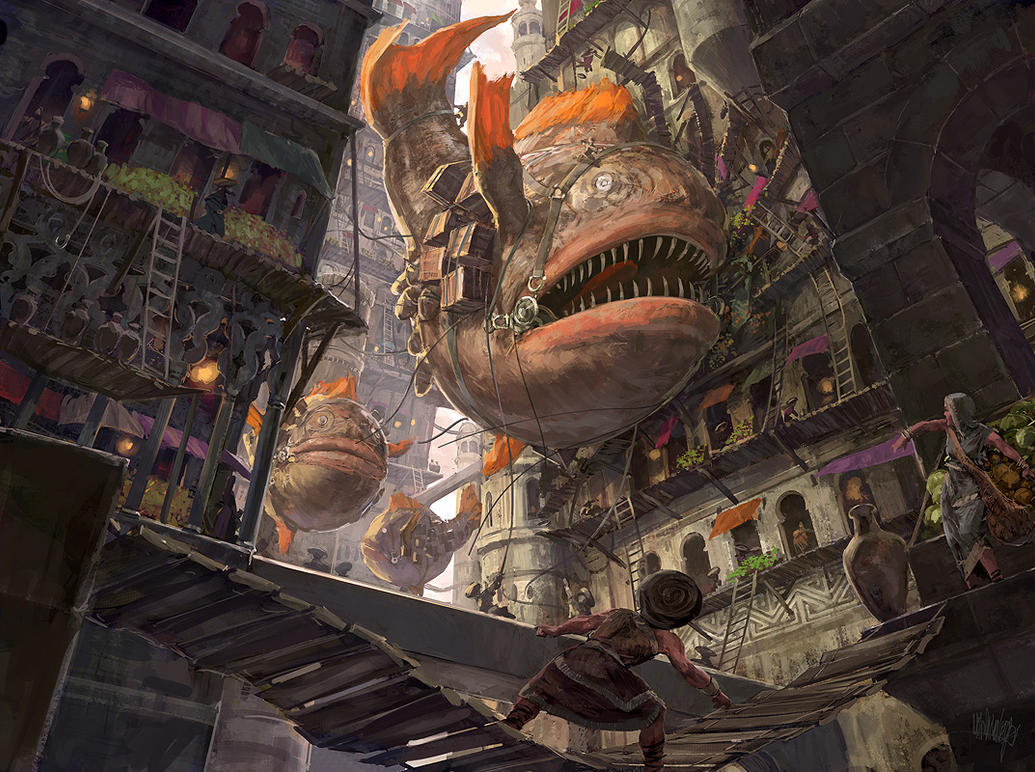 |
| Who drew it? Couldn't find it in the issue. |
Yeah, everyone else does the whole "review every issue" or "review every page" thing, so why the heck can't I?
Other than Great Britain and Iceland finally ending their codfish war (such a terrible waste), the first issue of
The Dragon (formerly
The Strategic Review) was probably the big highlight of June, 1976. So what does this little gem contain?
We have an article by Fritz Leiber, the man himself, talking about his wargame
Lankhmar and giving a brief tour of Nehwon. Leiber closes this article with a bit on houris. Here's an adaptation for
Blood & Treasure (you know, the game I haven't actually released yet).
Every hero (4th level fighter) attracts a
houri as one of his followers provided he has a charisma of at least 15. The houri requires upkeep to the tune of 100 gp per month. As Leiber explains, a houri is so "slimly beautiful" that she "make all men their helpless slaves and intoxicate even a Hero to madness". In play, this works as follows:
- Houris have 1d4 hit points (i.e. they can be killed by a dagger). They wear no armor, and may only wield a dagger themselves.
- All 0 or 1 HD male humans, demi-humans and humanoids within 10 feet of a houri must pass a Will saving throw or move directly toward the houri, rapt with fascination and unable to attack her (unless they are attacked by someone else, in which case the spell is broken).
- All higher level male characters within 10 feet of a houri must pass a Will saving throw or have their effective level cut in half.
Sounds like a useful follower to have, but heed the Mouser's warning - "Women are ever treacherous and complicate any game to the point of sheerest insanity."
---
Larry Smith provides a guide to running the Battle of Five Armies using the
Chainmail rules.
---
Wesley D. Ives provides a task resolution system, as he informs us that a "more standardized system is needed" than DM's just making it up as they go along. New School and Old School were clashing even back in 1976.
The system works by determining randomly a type of dice (by rolling d% and adding the attribute to be tested), from d4 to d12, rolling it and multiplying it by the attribute to be tested to find the percentage chance of success.
So, let's say I want to jump across a chasm. This involves strength, and my dude has a strength of 13. I roll d% and get a 35. I add 13 to 35 and get 48, which tells me I need to roll a d8. I roll it, get a 5 and multiply that by 13, giving me a 65% chance of success. See - much easier than saying "roll under your strength" or "roll a save vs. paralyzation" or "roll 1d6 - you succeed on a 1 or 2". Thank goodness for systems.
--
James M. Ward asks whether Magic and Science are compatible in D&D. Of course, he thinks it is (else it would be a pretty boring article). He introduces a race of people called the Artificers who use a trio of interesting high-tech items.
--
Lee Gold delves into languages. She notes that humanoids have a 20% chance of speaking Common, which makes much more sense than 3rd edition allowing dang near every sentient creature in the multiverse speaking Common (and thus negating the point of even having languages).
--
Jake Jaquet tells the tale of "The Search for the Forbidden Chamber". Check it out for a picture of the infamous "Greyhawk Construction Co. LTD" and a Recyclesaurus.
--
Len Lakofka presents some miniature rules that were apparently going to be used in a 64-man elimination tournament at GenCon.
--
The creature feature presents the ever-loving Bulette (pronounced boo-lay, except not really), with an illustration that is really quite good. The reproduction isn't perfect, but it's a nice action shot featuring three armored warriors (God, do I prefer realistic armor to some of the fantasy nonsense that seems to predominate these days). The stats note that its mouth has 4-48 pts and its feet 3-18 points - i.e. 4d12 and 3d6. It took me a minute, but I finally realized this was the damage they dealt.
The description notes that it is a hybrid of armadillo and snapping turtle, and that, when full grown, they can dwarf a Percheron (a draft horse that originated in the Perche Valley of northern France of course - man, don't you guys know anything?)
---
Mapping the Dungeons is a neat little feature, presenting the names of active DM's. The FLAILSNAILs of its day, I suppose.
---
Joe Fischer gives tips on mapping a wilderness. He uses colors for the terrains and simple symbols for features - triangles for hamlets, squares for towns, circles for cities and crosses for fortresses. Circle any of these for ports. Article has a nice Conanesque barbarian illustration as well.
---
Peter Aronson adds four more levels onto the illusionist, as well as a few extra spells (1st -
ventriloquism, mirror image, detect illusion*, color spray*; 2nd -
magic mouth, rope trick, dispel illusion*, blur*; 3rd -
suggestion, phantasmal killer*, illusionary script*, dispel exhaustion*; 6th -
mass suggestion*, permanent/illusion* (no - the slash doesn't make sense to me either),
shadow/monsters III*, programmed/illusion*, conjure animals, true sight*; 7th -
astral spell, prismatic wall, maze, vision*, alter reality*, prismatic spray).
The spells marked with an asterisk are detailed in the article, in case you wondered who invented
phantasmal killer. Lots of classic spells here.
Alter reality apparently works like a
limited wish, but you first create an illusion of what you want to happen, and then the ... spell description cuts off.
---
Lin Carter and Scott Bizar present "Royal Armies of the Hyborean Age", which reminds you of how important wargaming still was to the hobby then. I think wargaming is pretty basic to the experience, really, which is why I threw some basic rules into
Blood & Treasure for mass combat. I'm hoping to test them out this weekend with the daughter. She doesn't know this yet - so keep it under your hat.
---
Gary Gygax (you might have heard of him) gives rules for hobbits and thieves in
DUNGEON!, a game I so completely regret getting rid of I'd like to punch myself in the face.
---
"Garrison Ernst" (pseudonyms are as much a part of the history of this hobby as dice and beards) presents a chapter of "The Gnome Cache", in which he gives an introduction to Oerth and its place in the cosmos. Oerth is a parallel Earth with the same basic geography as Earth, it claims, save Asia is a bit smaller and Europe and North America a trifle larger. It is peopled by folks similar to ours, with similar migrations, but it separates from Earth about 2,500 years ago. He also explains the difference in scientific laws (i.e. magic vs. technology) and that nobody knows what lies in the Terra Incognita of Africa and across the Western Ocean.
It might be fun to draw the nations of Oerth on a map of Europe. We've all heard that Gygax's campaign was originally set in a fantasy North America, but here he says Europe, so perhaps Europe it should be.
--
Larry Smith now chimes in with the three kindreds of the Eldar - the Silvan (or Wood Elves), the Sindar (or Grey Elves) and the Noldor (or Exiles, the greatest of the elves). Apparently they all have a chance each game year of crossing the sea to the land of Valar - that would be a fun house rule to spring on players of elf characters.
"Say Bob, roll d% please"
"Okay ... got a 9"
"Sorry Bob, your 6th level wood elf just went to the land of Valar. Roll up a new character."
The wood elves can advance as fighters as far as they want, but are limited to 2nd level magic-user spells and may not use wands or staffs and have a 10% chance of going to Valar each year. Sindars are the regular D&D elves (and have a 25% chance of going to Valar each year). Noldor are uber elves with no level restrictions and with a 150% bonus to ranges and effects of spells. They have a 5% chance of going to Valar after performing a great deed.
Which begs the question, why would you ever play a non-Noldor elf?
--
Note: Totally digging the art in this issue.
--
Not a bad issue. Lots of goodies. I like the houri bit for fighters, the elves going across the sea is fun, and you get some neat hints about Lankhmar and Oerth from the guys who invented them. Worth the read.





































